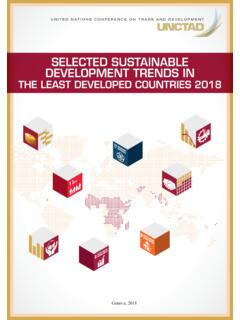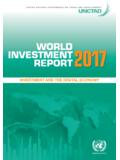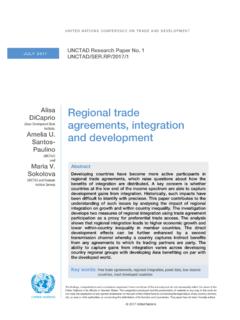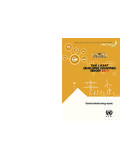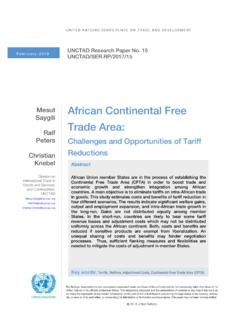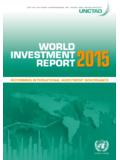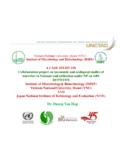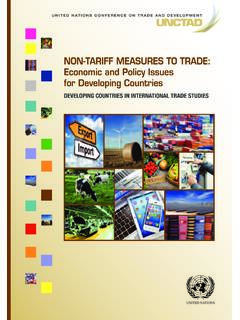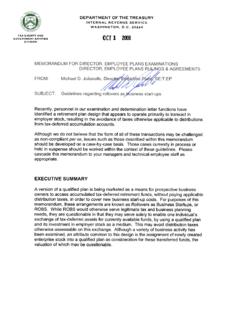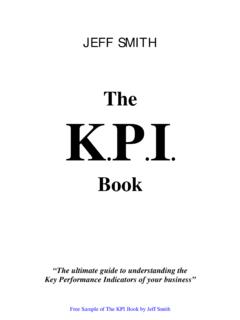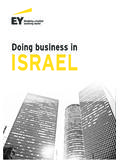Transcription of How to Prepare Your Business Plan - UNCTAD | Home
1 UNITED NATIONS CONFERENCE ON TRADE AND development How to Prepare your Business plan UNITED NATIONS New York and Geneva, 2002 ii Note UNCTAD serves as the focal point within the United Nations Secretariat for all matters related to foreign direct investment and transnational corporations. In the past, the Programme on Transnational Corporations was carried out by the United Nations Centre on Transnational Corporations (1975-1992) and the Transnational Corporations and Management Division of the United Nations Department of Economic and Social development .
2 UNCTAD seeks to create an enabling environment for international investment and enterprise development . Its work is carried out through intergovernmental deliberations, technical assistance activities, seminars, workshops and conferences. The term country as used in this study also refers, as appropriate, to territories or areas; the designations employed and the presentation of the material do not imply the expression of any opinion whatsoever on the part of the Secretariat of the United Nations concerning the legal status of any country, territory, city or area or of its authorities, or concerning the delimitation of its frontiers or boundaries.
3 In addition, the designations of country groups are intended solely for statistical or analytical convenience and do not necessarily express a judgement about the stage of development reached by a particular country or area in the development process. The reference to a company and its activities should not be construed as endorsement or acceptance by UNCTAD of the company or its activities. The following symbols have been used in the tables: Two dots (..) indicate that data are not available or are not separately reported.
4 Rows in tables have been omitted in those cases where no data are available for any of the elements in the row; A hyphen (-) indicates that the item is zero or its value is negligible; iiiA blank in a table indicates that the item is not applicable, unless otherwise indicated; A slash (/) between dates representing years, 1994/1995, indicates a financial year; The use of a dash (-) between dates representing years, 1994-1995, signifies the full period involved, including the beginning and end years; Reference to dollars means United States dollars, unless otherwise indicated; Annual rates of growth or change, unless otherwise stated, refer to annual compound rates; Details and percentages in tables do not necessarily add to totals because of rounding.
5 The material contained in this study may be freely quoted with appropriate acknowledgement. UNCTAD /ITE/11A/5 Copyright United Nations, 2002 All rights reserved Manufactured in Switzerland iv Preface This publication was prepared in the framework of a technical assistance project aimed at strengthening the capacity of least developed countries to mobilize resources through venture capital funds. It is intended for use in the training of senior and middle management in Business planning and as a reference manual for individual enterprises to Prepare their Business plans, for submission to investors for funding, including venture capital funds.
6 The manual is applicable to many types of businesses, including start-ups; on going or expanding businesses; production or service firms in any sector; small, medium or large corporations; sole proprietorships; partnerships; joint-stock companies; and locally, nationally or internationally active companies. It is thus unavoidable that the manual gives almost a maximum list of items for inclusion in a Business plan . Companies can pick and choose among the items discussed, according to their specific situations and needs.
7 Under the overall direction of Karl P. Sauvant and Anh-Nga Tran-Nguyen, this manual was prepared by George Malcotsis, in collaboration with Reinhard Behrens, Rene Gerber, Janos Fazekas, Dietmar Kuck, Andreas Ragaz and Lukas Sch rer. It has benefited from comments by Petri Koivula as well as by participants by in several training workshops to discuss Business plans, organized in Ukraine in 2001. UNCTAD is grateful to the Government of Norway, which financed the technical assistance within the framework of which this manual was prepared.
8 Rubens Ricupero Geneva, January 2002 Secretary-General of UNCTAD v Contents Page iv PART ONE: INTRODUCTION CHAPTER I: THE ABC OF A Business A. What is a Business plan ?..2 B. Why a Business plan ?..2 C. Who reads the Business plan ?..3 D. How to Prepare a Business plan ?.. 6 1. Who prepares a Business plan ?..6 2. What are the steps in the planning process?.. 7 a. Assessing the b. Developing a c. Getting 10 d.
9 Setting 11 e. Working out the Business 11 f. Setting employee 12 g. Monitoring the 12 E. What is expected from the investor/lender?..13 F. Different types of Business 13 G. Format and organization of a Business 17 H. Planning 19 I. Content and structure of a Business 23 PART TWO: BASIC ELEMENTS OF A Business plan CHAPTER II: EXECUTIVE 29 A. Purpose of the Business 30 viB. Main 31 C. Financial 32 D. Example of an executive 33 CHAPTER III: 36 A. Main products, markets and 36 B. Location and 37 C.
10 Key 38 D. Legal form, ownership and 38 E. Historical development and track record of the 39 F. Business strategy and 40 G. General organization/operating 40 CHAPTER IV: PRODUCTS AND 42 A. Product description and 42 B. Product 43 C. Research and 46 D. Product life 46 E. Costing and 48 1. 48 2. 50 a. Buyer's 50 b. Seller's point of 52 F. Production 55 G. Quality assurance and 57 H. 58 I. Intellectual 58 CHAPTER V: MARKETS, CLIENTS AND 60 A. Introductory 60 B. Market 61 C.
